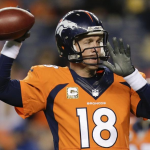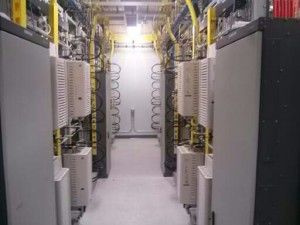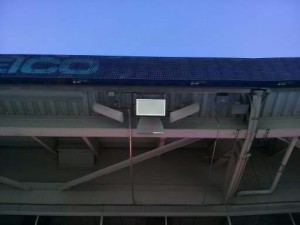 These days, Denver’s Sports Authority Field at Mile High is the new home of the NFL’s most prolific signal-caller. With a record season for passing yards and passing touchdowns, Broncos quarterback Peyton Manning is recognizable for his animated pointing, shouting and line-of-scrimmage audibles, the ultimate practicioner of last-second communication.
These days, Denver’s Sports Authority Field at Mile High is the new home of the NFL’s most prolific signal-caller. With a record season for passing yards and passing touchdowns, Broncos quarterback Peyton Manning is recognizable for his animated pointing, shouting and line-of-scrimmage audibles, the ultimate practicioner of last-second communication.
Not too long ago, the fans at Mile High might have had to resort to the same tactics to communicate, using hand waving or shouting, since getting a cell signal was next to impossible. “Forget making a phone call, you couldn’t even send a text,” said Rick Seifert, communications manager for the Broncos’ stadium management company. “And it wasn’t just the fans. We [the staff] couldn’t make calls in the stadium to do our jobs.”
But in 2012, the Broncos changed all that with the installation of a full-featured distributed antenna system (DAS) deployed by TE Connectivity, and a fan-facing Wi-Fi network installed by Verizon Wireless.
The Broncos also put in a huge new digital scoreboard and robust back-end connectivity provided by Comcast as part of their blitz of networking improvements, and this past fall, AT&T joined in by upgrading its connection to the stadium’s DAS. By next year the Broncos hope to add AT&T and Sprint to its roster of Wi-Fi service providers, reflecting what vice president of information technology Russ Trainor sees as a “never ending growth” of wireless in-stadium consumption.All carriers on board, slowly
One of the biggest problems with DAS deployments in stadiums is convincing major cellular carriers to work together. Since each carrier wants to deploy systems to do the best job for its customers, there is often a difference in opinion on strategy and operations, which is often followed by similar snags in contract negotiations. Trainor said that the stadium, built in 2001, presented unique RF challenges to wireless with its primarily exposed-steel construction. Verizon and Sprint were the first carriers to sign up for the neutral DAS, followed by AT&T this fall.
“It was tough to get them [all the major carriers] to agree on DAS, but we have good engineers on the back end and we came up with a nice solution for everybody,” said Trainor. While the antennas and stadium network are neutral, each carrier provides its own back-end gear, much of which at Mile High had to be placed in a building built outside the facility specifically to house telecom gear. In many stadium DAS deployments, the telecom gear can take up thousands of square feet, which can be challenging to find in facilities built before such needs were known.“There’s no room inside for all the space they [the carriers] wanted,” Seifert said.
The Wi-Fi network, deployed by Verizon, uses Cisco equipment and is also a neutral host infrastructure, meaning that other carriers could use it to provide Wi-Fi connectivity to their clients if they so choose. According to Seifert, AT&T and Sprint will offer Wi-Fi services to customers next season, in part to answer the consistently growing demand. Like in other stadiums, fans at Sports Authority Field know what to do when they finally find bandwidth: Use more.
Steady growth in wireless use
When Sports Authority Field is at its listed capacity of 76,125 on game days, it becomes the 14th-largest city in Colorado, Trainor said. The team has already seen 525,000 downloads of its mobile application, which provides such in-stadium features as four different video replay angles, a connection to the NFL Network’s RedZone channel, and a direct link to the radio feed from hometown sports station KOA. The application is geo-fenced to ensure that the video rights are only used inside the stadium, and to give fans there a unique game-day experience.
According to Trainor, the team usually sees an average of 4,000 simultaneous connections on the Verizon Wi-Fi network on game days, though on colder days when fans need to wear gloves that number can drop in half. Trainor said the Cisco infrastructure is designed to accomodate 25,000 concurrent connections, a number the team hasn’t yet reached. However, the team did have to double the back-end capacity already for the Wi-Fi network, which is being used more as more fans find it.“Word of mouth really gets [usage] going,” said Trainor, who noted that at a Kenny Chesney concert last year, the stadium crew saw data uploads outpace data downloads for the first time — a sure sign that fans in attendance were using the network to do things like share pictures and videos with their social-network connections.
“We haven’t seen any true bottlenecks yet, but usage is consistently rising, game after game, for concerts, soccer and football,” Trainor said.
A good sign from the Wi-Fi networking statistics is a shift in usage from the often crowded 2.4 GHz bands to the 5 GHz bands, which Trainor said is likely due to fans using the latest 5 series iPhones, which support the 5 GHz Wi-Fi frequency. And no matter what happens to the Broncos in the playoffs, Trainor and Seifert know what they will be doing this summer: Upgrading the network components, in the never-ending battle to provide bandwidth.“Verizon and Sprint have already made significant upgrades to their DAS deployments because of demand and changes in technology, like LTE,” said Seifert. “And next year we’ll probably see AT&T circle back again. It’s very dynamic.”
“As smart phones get smarter it’s a never-ending challenge” to provide connectivity, Trainor said. “It’s a job that’s never finished.”











[…] Stadium Tech Report: DAS, Wi-Fi puts end to no-signal problem at Denver’s Sports Authority Field —Mobile Sports Report “When Sports Authority Field is at its listed capacity of 76,125 on game days, it becomes the 14th-largest city in Colorado…” […]